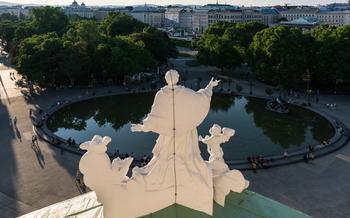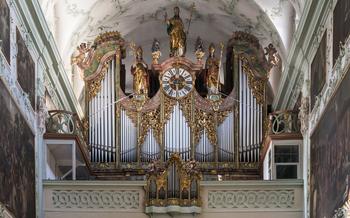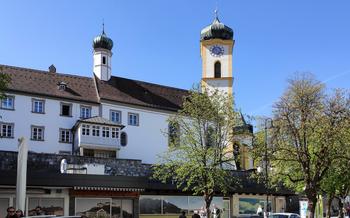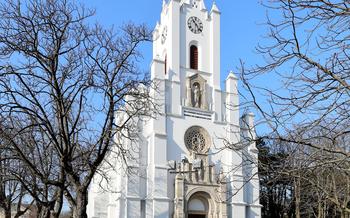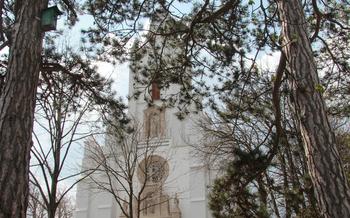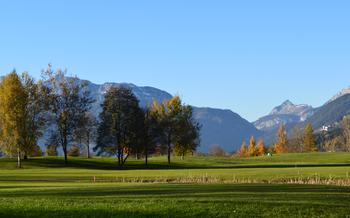
Salzburg Cathedral Excavations Museum
- The Salzburg Cathedral Excavations Museum: A Journey Through History
- Uncovering the Secrets of the Past: The Archaeological Site
- The Romanesque Crypt: A Hidden Gem
- The Early Christian Period: Foundations of Faith
- The Carolingian Era: A New Beginning
- The Romanesque Transformation: Elegance and Majesty
- The Gothic Period: Reaching for the Heavens
- The Baroque Era: Opulence and Splendor
- The 19th Century: Neoclassicism and Restoration
- The 20th Century: War and Reconstruction
- Special Exhibitions and Events: A Dynamic Cultural Hub
- Guided Tours: An Enriching Experience
- Educational Programs: Learning and Discovery
- Accessibility and Facilities: Ensuring a Welcoming Experience
- Insider Tip: Hidden Treasures
The Salzburg Cathedral Excavations Museum: A Journey Through History
The Salzburg Cathedral Excavations Museum is a captivating journey through time, taking visitors on an exploration of the rich history and evolution of the Salzburg Cathedral. This remarkable museum, located in the heart of the city, offers a unique glimpse into the archaeological treasures uncovered during excavations beneath the cathedral. Step inside and embark on a journey that spans centuries, revealing the secrets of the past and providing a deeper understanding of this iconic landmark. Whether you're a history buff, an architecture enthusiast, or simply curious about the hidden stories that lie beneath the surface, the Salzburg Cathedral Excavations Museum is a must-visit destination.
Getting to the museum is a breeze, as it's situated just a short walk from the Mirabell Palace and Gardens. Once you arrive, you'll be greeted by a wealth of exhibits, interactive displays, and multimedia presentations that bring the past to life. Prepare to be amazed as you uncover the secrets of the cathedral's foundations, dating back to the early Christian period, and marvel at the architectural wonders that have shaped this magnificent structure over the centuries.
Uncovering the Secrets of the Past: The Archaeological Site
The history of the Salzburg Cathedral Excavations Museum begins with the archaeological excavations conducted on the site of the cathedral in the 1950s. These excavations uncovered a wealth of artifacts and structural remains that shed light on the cathedral's rich and complex past.
Among the most significant discoveries were the foundations of an early Christian church, dating back to the 5th or 6th century. This discovery pushed back the known history of the cathedral by several centuries and provided evidence of the early Christian community in Salzburg.
The excavations also revealed the remains of a Romanesque crypt, built in the 11th century. The crypt is one of the best-preserved examples of Romanesque architecture in Austria and contains a number of important burials, including that of Archbishop Gebhard.
The artifacts discovered during the excavations are now on display in the museum, providing visitors with a glimpse into the cathedral's long and fascinating history. Interactive displays and multimedia presentations help to bring the past to life and offer visitors a deeper understanding of the cathedral's significance.
The Romanesque Crypt: A Hidden Gem
Beneath the grandeur of Salzburg Cathedral lies a hidden treasure: the Romanesque crypt. Constructed in the 11th century, the crypt is a remarkable example of early Romanesque architecture and serves as a testament to the rich history of the cathedral.
Visitors can descend into this subterranean realm and marvel at its unique features. The crypt is supported by sturdy pillars and barrel vaults, creating a sense of solidity and strength. Its walls are adorned with beautifully preserved frescoes depicting scenes from the Bible, providing a glimpse into the artistic and spiritual world of the Middle Ages.
Among the most notable features of the crypt are the intricately carved capitals that adorn the pillars. These capitals showcase a variety of motifs, including human figures, animals, and mythical creatures, each one a testament to the skill and artistry of the craftsmen who created them.
The crypt also contains a number of burials, including those of archbishops and other high-ranking members of the clergy. These burials are marked by elaborate tombstones and inscriptions, offering insights into the lives and legacies of these important figures.
Overall, the Romanesque crypt is a fascinating and atmospheric space that provides a unique perspective on the history of Salzburg Cathedral. Whether you are interested in art, architecture, or history, the crypt is a hidden gem that is well worth exploring.
The Early Christian Period: Foundations of Faith
The Salzburg Cathedral Excavations Museum houses a remarkable collection of artifacts that shed light on the early Christian period in the region. These artifacts, discovered during the archaeological excavations, provide valuable insights into the origins and development of Christianity in Salzburg. Among the most significant findings are fragments of early Christian pottery, jewelry, and coins, dating back to the 4th and 5th centuries AD. These artifacts indicate the presence of a vibrant Christian community in the area during this period.
The museum also displays evidence of early Christian worship, such as a baptismal font and fragments of a stone altar. These artifacts suggest that the site of the cathedral was used for Christian gatherings and rituals as early as the 5th century AD. The presence of these early Christian artifacts and structures highlights the importance of the Salzburg Cathedral as a center of Christian worship and community in the region since its inception.
Furthermore, the museum provides information about the significance of the early Christian community in Salzburg. The presence of a Christian community in the city during this period demonstrates the spread of Christianity beyond the major urban centers of the Roman Empire. It also suggests that Salzburg played a role in the dissemination of Christianity throughout the region, contributing to the establishment of the Christian faith in the area.
The artifacts and information presented in the Salzburg Cathedral Excavations Museum offer a glimpse into the early Christian period in Salzburg, highlighting the foundations of faith and the origins of the cathedral's significance as a center of Christian worship and community.
The Carolingian Era: A New Beginning
The Carolingian era, marked by the reign of Charlemagne, brought significant changes to the Salzburg Cathedral. Charlemagne, a powerful and influential ruler, had a profound impact on the development of the cathedral and the city of Salzburg as a whole.
Under Charlemagne's patronage, the cathedral underwent major architectural changes and additions. The most notable addition was the construction of a new westwork, a monumental entrance structure that served as a symbol of imperial power and authority. The westwork featured two towers, a central portal, and elaborate carvings depicting Biblical scenes and imperial iconography.
The Carolingian era also saw the construction of a new choir and apse, which replaced the earlier Romanesque structures. The new choir was larger and more elaborate, featuring a semi-circular apse with radiating chapels. This expansion reflected the growing importance of the cathedral as a center of religious and political power.
The Carolingian cathedral played a central role in the Carolingian Empire, serving as a place of worship, imperial ceremonies, and ecclesiastical gatherings. It was here that Charlemagne and his successors held court, received foreign dignitaries, and celebrated important religious festivals.
The legacy of the Carolingian era is still visible in the cathedral today. The westwork, with its distinctive towers and carvings, remains a prominent feature of the cathedral's exterior. The choir and apse, though modified over time, retain their Carolingian foundations. These architectural elements stand as testaments to the influence and power of Charlemagne and his dynasty.
The Romanesque Transformation: Elegance and Majesty
The Romanesque era marked a significant turning point in the history of the Salzburg Cathedral. During this period, the cathedral underwent a major transformation, transitioning from its early Christian and Carolingian roots to a grand and imposing Romanesque structure.
The Romanesque architectural style, characterized by its rounded arches, thick walls, and decorative elements, left an indelible mark on the cathedral's appearance. The nave was enlarged, and the transept was extended, creating a more spacious and majestic interior. The addition of a new apse, with its intricate carvings and colorful frescoes, further enhanced the cathedral's beauty.
Key features of the Romanesque cathedral include the impressive westwork, with its twin towers and elaborate portal, as well as the richly decorated capitals and columns throughout the interior. The influence of Romanesque art and culture is evident in the vibrant murals and sculptures that adorn the walls and altars, depicting biblical scenes and figures from the lives of saints.
During the Romanesque period, the cathedral served as a symbol of power and prestige, reflecting the rising influence of the church and the growing importance of Salzburg as a religious and cultural center. The grandeur and opulence of the Romanesque cathedral reflected the wealth and status of the archbishops and the city itself.
The Gothic Period: Reaching for the Heavens
The Gothic period, which spanned from the 12th to the 16th century, witnessed a profound transformation of the Salzburg Cathedral, propelling it into the realm of Gothic architectural masterpieces. The Gothic style, characterized by its soaring heights, intricate details, and abundance of light, left an indelible mark on the cathedral's appearance and atmosphere.
The construction of the Gothic cathedral commenced in the late 13th century, spearheaded by master builder Wolfgang. The existing Romanesque structure underwent extensive modifications, with the addition of a new choir, transepts, and a nave that stretched towards the heavens. The pointed arches, ribbed vaults, and flying buttresses became defining features of the cathedral's Gothic architecture, lending it an air of lightness and grandeur.
One of the most striking aspects of the Gothic cathedral is its intricate ornamentation. The exterior facade is adorned with a profusion of sculptures, depicting biblical scenes, saints, and mythical creatures. The interior is equally embellished with elaborate carvings, stained glass windows, and frescoes, creating a visually captivating space that invites contemplation and wonder.
The Gothic period also witnessed the construction of the cathedral's iconic twin towers, which became a defining landmark of Salzburg's skyline. The towers, reaching a height of over 80 meters, feature intricate Gothic tracery and delicate pinnacles, symbolizing the cathedral's aspiration towards the divine.
The result of these transformative modifications was a stunning Gothic cathedral that exuded a sense of awe and inspiration. The Gothic cathedral, with its soaring heights, intricate details, and abundance of light, became a masterpiece of Gothic architecture and a testament to the enduring legacy of this influential artistic movement.
The Baroque Era: Opulence and Splendor
The Baroque era, characterized by its grandeur, drama, and ornate decoration, left an indelible mark on the Salzburg Cathedral. In the 17th century, the cathedral underwent a comprehensive renovation under the direction of Italian architect Santino Solari. The Baroque style transformed the interior of the cathedral, adding a sense of theatricality and awe.
Solari's masterful design incorporated numerous Baroque elements, including intricate stucco work, opulent frescoes, and gleaming marble. The high altar, a focal point of the cathedral, was adorned with opulent sculptures and gilding, creating a sense of heavenly splendor. The pulpit, crafted from red marble and adorned with cherubs and garlands, further enhanced the Baroque aesthetic.
The Baroque renovation also included the addition of side chapels, each dedicated to a different saint. These chapels were adorned with elaborate altars, paintings, and sculptures, creating a rich and diverse visual experience. The overall effect of the Baroque transformation was one of grandeur, opulence, and spiritual elevation.
The Baroque era also saw the construction of the cathedral's iconic dome. Designed by Johann Bernhard Fischer von Erlach, the dome was an architectural masterpiece that dominated the Salzburg skyline. Its graceful curves and intricate ornamentation added a sense of majesty to the cathedral, making it one of the most recognizable landmarks in the city.
The Baroque renovation of the Salzburg Cathedral was a testament to the power and influence of the Catholic Church during this period. It transformed the cathedral into a symbol of the Counter-Reformation, a movement that sought to strengthen the Catholic faith in response to the Protestant Reformation. The cathedral's Baroque splendor served as a reminder of the Church's wealth, authority, and commitment to artistic excellence.
The 19th Century: Neoclassicism and Restoration
The 19th century marked a period of significant change and restoration for the Salzburg Cathedral. In the early 1800s, the cathedral underwent a major renovation inspired by the prevailing Neoclassical architectural style. This renovation aimed to restore the cathedral to its original Romanesque grandeur while incorporating elements of Neoclassicism.
The Neoclassical style emphasized symmetry, order, and simplicity, which were reflected in the changes made to the cathedral. The exterior of the cathedral was largely preserved, maintaining its Romanesque character. However, the interior underwent significant alterations, including the removal of Baroque elements and the introduction of Neoclassical motifs.
One of the most notable additions during this period was the construction of a new neoclassical altar. The altar featured clean lines, geometric shapes, and restrained ornamentation, reflecting the Neoclassical aesthetic. The nave and aisles were also redecorated with Neoclassical elements, creating a harmonious and unified interior space.
The restoration efforts in the 19th century were not limited to the interior of the cathedral. The surrounding grounds and gardens were also redesigned in the Neoclassical style. New landscaping, pathways, and fountains were added, creating a cohesive and aesthetically pleasing environment around the cathedral.
The 19th-century renovations and restoration played a crucial role in shaping the current appearance of the Salzburg Cathedral. The combination of Romanesque and Neoclassical elements created a unique architectural style that is both historically significant and aesthetically appealing. Today, the cathedral stands as a testament to the diverse artistic and cultural influences that have shaped its history.
The 20th Century: War and Reconstruction
The 20th century brought both destruction and renewal to the Salzburg Cathedral. During World War II, the cathedral was severely damaged by Allied bombs, with much of its roof and interior destroyed. After the war, extensive reconstruction and restoration efforts were undertaken to bring the cathedral back to its former glory.
The reconstruction process was a meticulous and challenging task, as the goal was to restore the cathedral to its original state while preserving its historical integrity. Skilled craftsmen and artisans worked tirelessly to repair the damaged stonework, rebuild the roof, and restore the intricate interior decorations.
The reconstruction efforts were largely successful, and the Salzburg Cathedral was reopened to the public in 195Today, the cathedral stands as a testament to the resilience of the human spirit and the enduring power of faith. Its restoration serves as a reminder of the importance of preserving our cultural heritage, even in the face of adversity.
In recognition of its outstanding cultural and historical significance, the Salzburg Cathedral was designated a UNESCO World Heritage Site in 199This designation further underscores the cathedral's importance as a symbol of Austrian heritage and a masterpiece of Gothic architecture.
Special Exhibitions and Events: A Dynamic Cultural Hub
The Salzburg Cathedral Excavations Museum is not just a static repository of artifacts; it is a dynamic cultural hub that hosts a variety of temporary exhibitions and events throughout the year. These exhibitions and events focus on different aspects of the cathedral's history, culture, and significance, offering visitors a chance to engage with the museum's collections in new and exciting ways.
Special exhibitions often delve into specific themes or periods in the cathedral's history, showcasing unique artifacts and providing in-depth insights into the lives and times of those who built, used, and worshipped in the cathedral. These exhibitions are a great opportunity to learn more about the cathedral's rich history and the people who shaped it.
Events at the museum can range from lectures and workshops to concerts and performances. These events provide a platform for scholars, artists, and musicians to share their knowledge and passion for the cathedral with the public. Visitors can attend lectures by renowned historians, participate in hands-on workshops related to archaeology and art, or enjoy musical performances that bring the cathedral's history to life.
To stay updated on upcoming exhibitions and events, visitors can check the museum's website or follow its social media channels. These platforms provide up-to-date information on current and upcoming exhibitions, as well as details on how to book tickets and participate in events.
Guided Tours: An Enriching Experience
The Salzburg Cathedral Excavations Museum offers guided tours in various languages, providing visitors with an enriching and informative experience. These tours are led by knowledgeable guides who share their expertise and insights on the museum's exhibits and the history of the cathedral.
Benefits of Taking a Guided Tour:
-
Personalized Experience: Guides can tailor their explanations to the interests and questions of the group, creating a more personalized and engaging experience.
-
In-Depth Knowledge: Guides have undergone extensive training and can provide detailed information about the museum's artifacts and the history of the cathedral, offering a deeper understanding of the site.
-
Storytelling: Guides bring the museum's exhibits to life by sharing captivating stories and anecdotes, making the visit more memorable and enjoyable.
What to Expect During a Guided Tour:
-
Comprehensive Overview: Tours typically cover all the major highlights of the museum, including the archaeological site, the Romanesque crypt, and the various periods of the cathedral's history.
-
Interactive Engagement: Guides encourage questions and discussions, fostering an interactive and participatory learning environment.
-
Immersive Experience: Guides use multimedia presentations and interactive displays to enhance the tour experience and provide a deeper understanding of the cathedral's history and significance.
How to Book a Guided Tour:
-
Advance Reservations: It is advisable to book guided tours in advance, especially during peak tourist season, to secure a spot and avoid disappointment.
-
Group Tours: Guided tours can be arranged for groups of various sizes, making it a great option for families, friends, or educational groups.
-
Language Options: Guided tours are available in multiple languages, including English, German, French, and Spanish, catering to international visitors.
Educational Programs: Learning and Discovery
The Salzburg Cathedral Excavations Museum offers a range of educational programs designed to engage and inspire visitors of all ages. These programs provide an opportunity to delve deeper into the history, archaeology, and cultural significance of the cathedral and its surroundings.
Families can participate in interactive workshops that allow children to learn about the different periods of the cathedral's history through hands-on activities and storytelling. School groups can book guided tours tailored to their curriculum, exploring specific themes such as Romanesque architecture or the role of the church in medieval society.
The museum also offers lectures, seminars, and workshops for adults, covering topics such as the latest archaeological discoveries, the restoration of the cathedral, and the influence of the cathedral on art and music. These programs provide an opportunity for visitors to engage with experts in the field and gain a deeper understanding of the cathedral's significance.
To participate in educational programs, visitors can contact the museum's education department in advance to inquire about available programs and make reservations. The museum's website also provides information on upcoming programs and events.
Accessibility and Facilities: Ensuring a Welcoming Experience
The Salzburg Cathedral Excavations Museum is committed to providing a welcoming and accessible experience for all visitors. The museum is wheelchair accessible, with ramps and elevators available throughout the building. There are also accessible restrooms and designated seating areas for visitors with disabilities.
For those who are deaf or hard of hearing, the museum offers assistive listening devices. Visitors can also borrow wheelchairs and strollers from the museum's front desk.
The museum has a gift shop where visitors can purchase souvenirs, books, and other items related to the cathedral and its history. The gift shop also sells a variety of educational materials for children.
Ticket prices for the Salzburg Cathedral Excavations Museum vary depending on the type of ticket and the age of the visitor. There are discounts available for children, students, and seniors. Visitors can purchase tickets online or at the museum's ticket counter.
To make the most of your visit, it is recommended to plan ahead. Check the museum's website or call ahead to inquire about special events or exhibitions. Guided tours are available in various languages, and educational programs are offered for different age groups.
With its accessibility features, facilities, and educational programs, the Salzburg Cathedral Excavations Museum provides a welcoming and enriching experience for visitors of all ages and abilities.
Insider Tip: Hidden Treasures
Beyond the main exhibits, the Salzburg Cathedral Excavations Museum holds a hidden treasure that often goes unnoticed by visitors. Tucked away in a corner of the museum, you'll find a small room dedicated to the medieval graffiti that was discovered during the excavations. These intricate markings, etched into the walls by pilgrims and visitors over the centuries, offer a glimpse into the personal stories and devotions of those who came before us.
To discover this hidden treasure, simply ask a museum staff member to direct you to the room where the graffiti is displayed. Once there, take your time to examine the delicate lines and symbols that adorn the walls. Each mark tells a story, whether it's a prayer for guidance, a plea for healing, or simply a name left behind by a traveler passing through.
The medieval graffiti at the Salzburg Cathedral Excavations Museum is a reminder that even the grandest of structures holds secrets and stories waiting to be uncovered. As you explore these hidden treasures, you'll gain a deeper appreciation for the rich history and cultural significance of this remarkable place.


